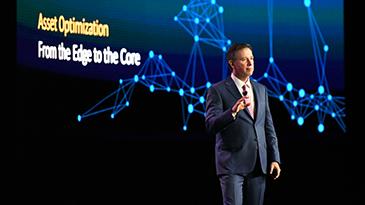It was an honor to participate in this year’s FT Digital Energy Summit, hosted for the fourth time by the Financial Times in London, and moderated by leading FT reporters across energy and technology disciplines.
Executive-level delegates from the global energy sector gathered to discuss, debate and define the impact of digital transformation strategies both today and in the future. Morning sessions focused on macroeconomic and other trends affecting the energy sector. Natalie Thomas, energy correspondent for the FT, stated without fanfare and with absolute clarity: “The challenges are complex and multiple.”
We also heard from Mark Lillie, a partner at Deloitte who ran an interactive session polling the room of energy executives on a variety of questions about issues surrounding technology, process and people as the industry transforms. He talked about the potential of technology such as predictive maintenance and its ability to “transform where you invest in your assets,” which can be a game-changer for our customers.
The panel I took part in focused on Leadership in the Digital Era — a fascinating issue we all face as we navigate both the challenges and the opportunities presented to us by digital transformation. I was on stage with Carol Borg, chief financial officer of Lightsource BP; Ziya Erdem, CEO of Enerjisa Enerji; and Mike Young, group chief information officer of Centrica. We were moderated by Malcolm Moore, technology news editor at the FT.
We discussed the expectations of the CEO and board in the execution of digital strategies, and how the rest of the C-suite can collaborate and enhance progress in these vast and often long-established firms.
It is clear that digitalization will necessitate change. Innovative and varied approaches to leadership will be required to effectively address changes in organizational structures and operating models. The evolution of culture within a business will also need to be a priority.
It Starts at the Top
My belief is that this cultural change absolutely starts with the CEO making digitalization the corporate goal. Digital transformation fundamentally changes the accepted working practices within many operations. To the extent that decision-making can be automated, the existing workforce will now share ownership of processes with technology and machines.
Executives should therefore be mindful of a resistance to change. While everyone benefits from a more agile and faster-moving organization, there will always be some that see change as being driven by the need to fix a process they are managing. They won’t necessarily associate the change with the fact that the process is in need of an upgrade.
By choosing a high-value project first and including everyone in the definition of the digital outcome, you improve your ability to execute as a cross-functional team. This will enable everyone to participate in the solution, with nobody left behind. Digital transformation benefits everyone — employees just need to be shown the new opportunities, which are open from inception, to advance both the business and their careers.
CEOs also need to show that they are not afraid to take a calculated risk and are willing to invest for success. Digitalization can build a competitive advantage to connect more deeply with customers — laggards on the journey will find themselves disproportionately disadvantaged very quickly. Layer on new levels of learning and technology throughout the journey. That is a very new mindset within most process industries. The collision of traditional operational technology (OT) and information technology (IT) will bring challenges as well as opportunities.
It’s fascinating to think that many executives within capital-intensive industries started in engineering and have worked within many different departments and roles as they have built their experience to become business leaders. Deterministic outcomes are a special trait within engineering-based cultures, yet the transformation will be driven by those who can also execute against a series of non-determined outcomes — and who can do so with courage and with the patience and support of the team around them.
Leading CEOs, whatever their background, have earned the role because they know how to form priorities, they have the conviction to see them through, they are not afraid to embrace new thinking, and they accept that they have to keep learning. Leadership in the energy sector in the 21st century is about understanding how to layer new technologies and how to drive a cultural transformation that builds on existing foundations. IT operations did it when transforming to the cloud, and now OT must do it to become digital and thrive.
So, while I agree with Natalie Thomas’ opening remarks that the challenges are complex and multiple, I also believe that effective leadership will navigate those challenges with great success. As one customer said, “Fail fast and learn.”
To see what others have been saying about the conference, follow #FTDigiEnergy on Twitter.






Leave A Comment